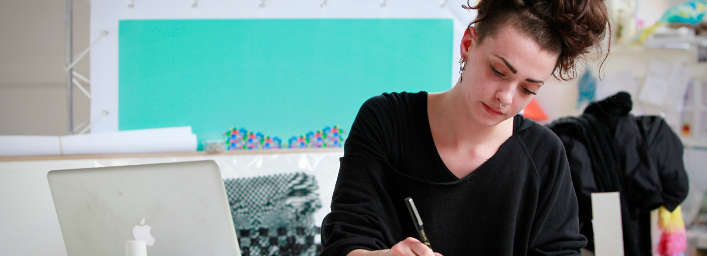
In this post, Lynsey Russell-Watts, Careers Consultant for ECA, discusses her involvement in the recent Graphic Design in a Box project. This aimed to improve design-related careers resources in schools, but the final-year students involved also gained a wide range of career benefits from their participation.
Making the leap from one side of the academic fence to the other has allowed me to keenly appreciate the concerns and priorities of those on each side. As a lecturer, my priority was to engage my students in their subject. ‘Career’ was something that students did afterwards. I might ask final year tutees if they had thought about what they were going to do afterwards, but it was certainly not the focus of my teaching. Of course I believed students were developing ‘transferable skills’, but I was largely concerned with the nitty-gritty of the immediate skills they had to develop to perform well in their assessments!
On the ‘other side’, as a careers consultant, I see things rather differently. It wasn’t that I was wrong in my approach before, but I didn’t really grasp that the twin concerns of academic performance and career aspiration could be interconnected. I also now appreciate the importance of students engaging in thinking about their future careers as early as possible. This doesn’t mean they have to be fixed on a career path, but rather that they should make the most of their university experience (develop new skills, broaden horizons and networks through part-time work, student societies, or volunteering). Although I value education for its own sake, the vast majority of students come to university because they believe it will improve their employment prospects. We can’t afford to ignore this concern.
Being involved in the Graphic Design in a Box project allowed me to see how career education can be integrated into students’ subject-based study. This project involved final-year graphic design students devising a design solution for the ‘problem’ of school career guidance. Drawing on their own experiences, and those of current pupils, they designed innovative resources to inform and inspire young people about what it might mean to study graphic design, and what kind of jobs such study might lead to.
Whilst there was clearly a role for me in supporting the students through that process, where the project came into its own from a careers perspective was in the follow-up workshop I did with the students. Asking students to complete a skills audit (rating themselves against a list of skills commonly required for graphic design and other graduate jobs) demonstrated that there were very few relevant skills they had not improved during the project. The students worked in teams to produce their resource to a tight deadline, and liaised with school pupils to gather information and insights from them: they now had a rich seam of experience to mine for examples of problem-solving, creativity, communication, team-working, organisation, and so forth.
This led me to reflect on my previous teaching experience: how often had I asked students to really reflect on their learning and on the range of skills and experiences it provided? Without changing much, I could have helped them to articulate how their group presentations, research projects and seminar participation developed and demonstrated a range of valuable skills, or how their skills in close reading and written communication would be essential in decoding job advertisements and responding to them. More than that, I could probably have designed other activities which would have enhanced both their academic skills and their career readiness. The most effective career education is embedded within what students are already doing – its relevance is clearer that way. Career education should add value to the higher education experience, not devalue it, since it is about making explicit higher education’s wide range of benefits, in ways which enhance our students’ career readiness and employability.
Next steps: Read more about Graphic Design in a Box in Zoe Patterson’s blog post for Teaching Matters


